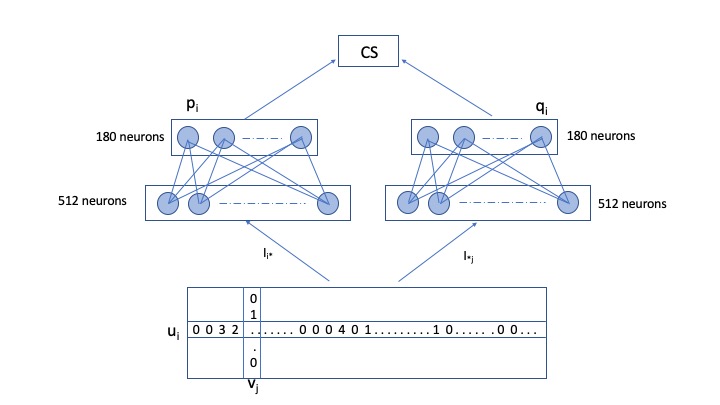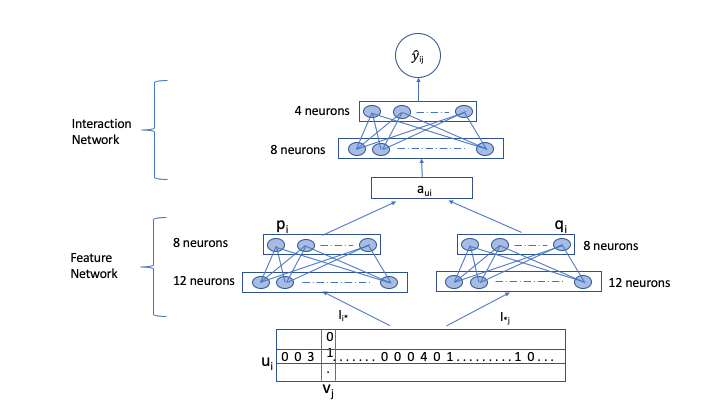Matrix Factorization methods for Recommendor Systems
This project compares two deep learning methods used in recommendation systems and compares the results of these methods on MovieLens dataset.
Abstract
Recommender systems are widely used tools to make personalized recommendations to individuals. Neighborhood and factor models have been extremely popular techniques in the field of recommender systems. However, given the successful application of neural networkbased techniques in other fields of technology such as computer vision and natural language processing, it is reasonable to believe that neural network-based techniques would also perform well in recommender systems. This paper will be comparing two neural network-based approaches that incorporate both explicit ratings and implicit feedback as inputs. The first approach is a deep matrix factorization model which uses a neural network architecture to perform matrix factorization. The second is joint neural collaborative filtering method which uses a joint neural network to perform both feature learning and interaction modeling. Both models outperform the best traditional methods.
Introduction
It is currently effectively impossible to navigate manually all options and data available today. Recommender systems (RSs) are tools that help shorten the time it takes to find a desirable output, be it music in Spotify, products on Amazon, or movies on Netflix. The most common technique used in recommender systems is collaborative filter, popularized in a 2006 Netflix competition. Collaborative filtering makes use of matrix factorization to model user-items interactions, using users with similar to tastes to provide a scalable, flexible and simple recommendation process. The process utilizes user ratings, explicit feedback of user preference, like most early recommenders but it solves the associated scarcity problem by also utilizing implicit feedback. This implicit information include indirect information like purchase history, clickstream, analysis, and other non-direct data to help recommend users products. This results in an increase in amount and complexity of information, thus making deep learning methods a good choice to capture the most information. This paper attempts to recreate the model proposed by Deep Matrix Factorization Models for Recommender Systems [1] which makes use of both explicit and implicit feedback as inputs A new loss function is also proposed to better optimize the results. Experimental results show this method outperforms other available recommendation methods. We will also be comparing the results of the model with the one proposed by the Joint Neural Collaborative Filtering for Recommender Systems paper
Data
The MovieLens data set was used in this analysis(movielens.umn.edu). The data were movie reviews collected by the University of Minnesota from the MovieLens website from September 19th, 1997 through April 22nd, 1998 and consists of ratings from 943 users on 1682 movies. This dataset is considered a benchmark for recommender system research. In Figure 1a below the x-axis denotes the number of ratings and y-axis indicates the corresponding user counts. 61.72% of users had 100 ratings and were considered “inactive users” (<100 ratings). 32.66% had 100-300 ratings, and only 5.6% had >300 ratings. Ratings in the data set are on a scale of 1-5, with the most and second most common rating being 4 and 3 respectively.
A user’s known rating is an ‘interaction’ between the user and movie. Unwatched movies are ratings without values and are assumed to be ’non-preference implicit feedback’ while actual ratings are known as ‘explicit feedback’. This dataset has 100k ratings and the remaining 1,486,126 unrated interactions are implicit non-preference zero rating.
Methods
In this project we comapred two deep learning methods, Deep Matric Factorization and joint neural collaborative filtering.
Deep Matric Factorization
The DMF model is inspired from Deep Structured Semantic Models (DSSM) proposed in for web search. The network architecture for DMF method is shown in Figure below. Each user and movie are represented as sparse vectors from the interaction matrix. These vectors are individually passed through a neural network, each layer of which maps these vectors in smaller spaces. The final latent representations of users and movies are p and q respectively. The final output is calculated as the cosine similarity (CS) between p and q . The latent representations of users and items indicate the user and item profile to some extent.

Joint Neural Collaborative Filtering
The J-NCF model applies a joint neural network that couples deep feature learning and deep interaction modeling with the rating matrix. This method uses two neural networks to learn low dimensional latent features for users and movies. Next, the latent features are merged and passed through another neural network to learn the complex interaction between between users and movies. The network architecture for JNCF is shown below in Figure below.
The JCNF paper investigates two ways of modelling user-movie interaction
- Non-linear fusion: this method concatenates the user and movie latent vectors (JNCF-c)
- Linear kernel : this method does an element-wise multiplication of the latent vectors (JNCF-m)

Results
Typical error metrics such as the normalized log loss and mean square error (MSE) do not capture the performance of top-N recommendation systems well. Many early works suggest that an improvement in MSE or normalized log loss does not necessarily improve the 7 recommendation task. The metrics that capture the recommendation accuracy well are Hit Ratio (HR) and Normalized Discount Cumulative Gain (NDCG) . HR is used to evaluate the precision of the recommender system, i.e., if the test item is contained in the top-N list, then it is deemed as Hit. NDCG measures the ranking accuracy of the recommender system. It assigns higher importance to results at top ranks, while scoring successively lower ranks with marginal fractional utility.
The JNCF-c and JNCF-m methods achieved lower metrics than the DMF as well as the EMF methods. Figures 6 and 7 below shows the graphs for HR and NDCG for both the variants of JNCF method. The EMF method achieves marginally lower metrics than the DMF method. We experimented with three layers for this method. Network with 2 layers performed better than the others.
